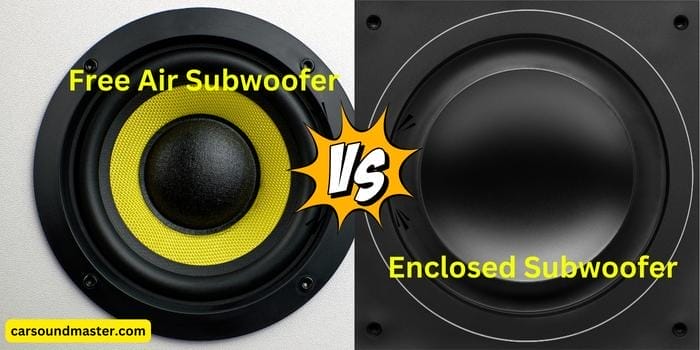2 Ohm Vs 4 Ohm Subwoofer – What Hits Harder?
A subwoofer is simply any other speaker on your car except that it specializes in sounds from only the lowest region of the audible spectrum – we call it “bass”.
That’s why the battle of 2 Ohm vs 4 Ohm subwoofers is not a bit different from what’s the story with 2 Ohm and 4 Ohm car speakers.
It’s also a contest altogether between SPL and SQ. A 2 Ohm subwoofer will proffer less resistance to the amp, draw more power, and hence sound quite louder.
However, the sound out of a 2 Ohm sub is more prone to distortion due to the sub’s higher power consumption.
Whereas, a 4 Ohm subwoofer will present more resistance, sip belted watts, and hence sound pretty quiet. But sure bet, the sound quality here is way too neat, clean, and impactful.
What else? Let’s turn inside out.
Subwoofers and the Role of Impedance
Subwoofers are essentially one of the key elements of a stereo or surround setup. They handle the most difficult range of frequencies and add that rare real feel and texture to the audio part of your infotainments.
The impedance (i.e. resistance) of a subwoofer is the measure of how much a subwoofer can resist incoming electric signals. And that, after all, is what gives you quite an accurate snap of how deep or booming the bass or sounds to expect.
This very thing (i.e. the impact of impedance on intensity) is somehow so closely related to the impact of the sub’s type on its sound quality like what we saw in free air vs enclosed subs.
Subs with lower resistance, those rated at 2 Ohms, would sound more like free air or ported subs focusing more on booming bass and more volume but will eventually distort up there.
While 4 Ohm subs tilt more toward the sealed subwoofer type throwing a bit quiet but more clean and profound sounds with no hints of going off-color no matter the volume levels.
2 Ohm Vs 4 Ohm Subwoofer
Let’s now evaluate both these versions of subwoofers based on some key factors and see as to which one may suit you the best.
Sound Intensity and Quality
Here’s starting with the key determinant that often entirely shapes your purchase decisions.
2 Ohm Subwoofer
A rating of 2 Ohm means very little resistance posed to the amplifier which, in other words, means allowing more current to easily come in. The more watts coming in directly translates into more projection i.e. a tad bit extra booming bass.
That loudness may sound like a good thing; sure it is, but only until you turn the volume knob to the highest point.
On high volumes, you’d now hear a lot more other hiss, hums, and such electrical tumults that will totally ruin the quality of the music leaving no note easily readable.
It happens solely because the higher power consumption of these subs eventually results in all sorts of raw and uncooked signals also easily passing to and through the voice coil.
4 Ohm Subwoofer
A resistance of 4 Ohm means double the defiance to the current. So a 4 Ohm sub would eventually draw half the watts from the amp which ultimately translates into lower projections – not booming but tight and impactful bass.
However, more resistance means more check-and-balance too. Thus, a 4 Ohm circuit won’t allow but only the apt and refined signals to barge in which is ultimately the reason why a 4 Ohm sub sounds much clearer and definite even at higher volumes too.
Work Efficiency and Compatibility
The 2nd most important deciding factor is the work effectiveness and prevalence.
2 Ohm Subwoofer
An impedance of 2 Ohm belongs somewhere to the lowest region of the resistance gamut which means a very low circuit resistance offered to the amp.
That said, 2 Ohm subs need double the power to produce the same amount of sound as a 4 Ohm sub. In other words, that means 2 Ohm subs are half as efficient as the others.
4 Ohm Subwoofer
On the contrary, 4 Ohm subs are twice as efficient as their 2 Ohm counterparts. They usually come stock standards in vehicles nowadays because car amps are powered through a DC source and 4 Ohm is a decent resistance for DC circuits.
A 4 Ohm sub is a good purchase for home theaters as well esp. if you want to save a bit on your electricity bills. Because if an amp is rated at 200 watts for a 2 Ohm subwoofer, it will need half the watts to compensate for a 4 Ohm sub.
Durability
How long your gimmick will accompany you is in no way a less important consideration to take.
2 Ohm Subwoofer
Because 2 Ohm subs are built to stand a higher influx of watts into and through its miniature circuitry continuously, they’ve got smaller lifespans and quicker depreciation.
4 Ohm Subwoofer
Compared to their 2 Ohm siblings, 4 Ohm subs have half as much pressure of electrical energy on their minuscule parts; so they find it twice as easy to hold up together for longer terms.
Availability and Pricing
General overview.
2 Ohm Subwoofers
These are usually priced with relatively bitter tags and may not be as easily available as the other ones.
The exceptional engineering of 2 Ohm subs to make their miniature components easily withstand higher watts, and the lack of market competition in these versions are most probably the two big reasons for their higher prices.
4 Ohm Subwoofers
On the other hand, 4 Ohm subs are the norm in vehicles as well as a top go-to choice for home and other setups as well. So they make it for tough competition in the market and are thus priced relatively delicately.
First Thing First – Match the Impedances Before Making the Final Purchase
Apart from all the above factors, check out the impedance rating of your amp or receiver before you finally decide on one of the two subs’ versions.
This, quite, applies if you want to continue with the same existing amp; if you’re to upgrade the amp as well, no need to read the next paragraph.
A difference in the impedance rating of your amp and sub may lead you into a disaster. If your amp is rated at higher than the sub’s impedance, the former will blow away; vice versa may happen if you wire subs with higher impedance to a low-resistance amp.
Single Voice Coil (SVC) Subs
As their name suggests, these subs feature a solo voice coil off the manufacturing belt, and their impedance is already set. They usually come at 2, 4, or 8 Ohms.
Dual Voice Coil (DVC) Subwoofer
With subwoofers flaunting two voice coils, you get quite the freedom to tweak their impedance to best suit your existing amplifier. The two voice coils may be the same or may feature varied impedances.
A DVC sub comes in handy when you’ve an amp that’s rated at a different impedance than your subwoofer. If the amp is rated at 4 Ohms while the subwoofer you got is a DVC rated at 2 Ohm, you can easily open it up, and wire the two voice coils in series to interpolate 4 Ohm off it.
Conversely, if your amp is rated at 2 Ohm whereas your DVC subwoofer is at 4 Ohm, you can wire the voice coils in parallel to bring the total resistance down to 2 Ohm. I hope you know the effect of wiring on the total resistance of speakers or subs – if not, read this (wiring speakers in series vs parallel).
How to Test/Verify the Subwoofer’s Impedance Ratings?
A lot of, newbies I’d say, don’t know much about all this fuss. For them, know that it’s not the labeled output power but the rated impedance (denoted by Ohm “Ω”) that has the final say re. how loud or quiet the output to expect.
Like most of the other details, the impedance rating of the speakers is also labeled on the original box so you can refer to the packaging to confirm. If not, check the manufacturer and confirm the model no. from the box and search online to get the idea.
Other ways you can check them include opting for a bit of complex engineering and checking via a multimeter or finally, by listening to both of them at the same time at the same volume level (preferably, the highest).
At high volumes, the one with more booming but shaky bass will be the 2 Ohm model, whereas the one feeling a bit tight-n-quiet but absolutely clean will be the other one.
Final Thoughts – Is 4 Ohm or 2 Ohm Better for Subs? Which One to Choose?
So where is this battle gonna end? Well, nowhere. The choice between a 2 Ohm vs 4 Ohm subwoofer will always entirely hinge on your personal preference of things.
If you’re looking for more booming bass and don’t bother much with the sound coloration on higher volumes and, of course, if you have an amp as powerful as one easily handling a meager 2-Ohm resistance, get a 2 Ohm sub.
Conversely, if you prefer high-fi, clean, and emphatic bass over merely empty noise and also want to not overdraw your amp, go with a 4 Ohm sub.
If we just briefly revisit the pros and cons of both, we see that 4 Ohm subwoofers have quiet but quality distortion-less bass, they are more efficient, more durable, and quite inexpensive as well. They only fall short of their 2 Ohm siblings in that extra boom.
The actual performance of both of them may still vary with other things like the placement of the subwoofer, the type of content you hear out of it, etc.







